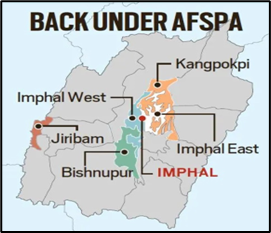Why in news?
The Centre has reimposed the Disturbed Areas status under the Armed Forces (Special Powers) Act (AFSPA) in six police station jurisdictions in Manipur, citing a volatile situation and the involvement of insurgent groups in violent acts.
This includes areas in the Imphal valley, such as Sekmai, Lamsang, Lamlai, Moirang, Leimakhong, and Jiribam. The status had been rolled back in these areas between April 2022 and April 2023, just before the ongoing ethnic violence began.
Jiribam, located on the border with Assam, and other areas affected by the conflict, now fall under the reimposed AFSPA.

While the reimposition may not immediately change operational dynamics, it is expected to increase caution among security forces and disrupt insurgent activities.
The AFSPA has been in effect in Manipur since 1980, with gradual withdrawals and reintroductions based on the security situation.
What’s in today’s article?
- Armed Forces (Special Powers) Act, 1958
Armed Forces (Special Powers) Act, 1958
- Background
- AFSPA has its origins in British-era legislation enacted to suppress the Quit India Movement.
- In 1947, it was introduced as four ordinances, which were replaced by an act in 1948.
- The current law, enacted in 1958 by then-Home Minister G.B. Pant, was initially named the Armed Forces (Assam and Manipur) Special Powers Act.
- As new states like Arunachal Pradesh, Meghalaya, Mizoram, and Nagaland were formed, AFSPA extended to cover these areas.
- About
- The Armed Forces (Special Powers) Act was enacted in 1958 to bring under control what the government of India considered disturbed areas.
- Enacted by Parliament in September 1958, AFSPA was first implemented in the Northeast, and then in Punjab.
- Under its provisions, the armed forces have been empowered to open fire; enter and search without warrant, and arrest any person who has committed a cognisable offence.
- Prosecution of the officer on duty needs prior permission of the Central Government.
- States where AFSPA is in effect
- AFSPA can be implemented in an area after it has been declared as disturbed.
- Currently, AFSPA is in effect in parts of Nagaland, Assam, Manipur, and Arunachal Pradesh.
- It was completely lifted from Meghalaya in April 2018. It was repealed in Tripura in 2015
- Disturbed Area
- A disturbed area is one which is declared by notification under Section 3 of the AFSPA.
- Section (3) of the AFSPA Act empowers the governor of the state or Union territory to issue an official notification on The Gazette of India.
- Following which the centre has the authority to send in armed forces for civilian aid.
- The state or central government considers those areas as disturbed by reason of differences or disputes between members of different religious, racial, language or regional groups or castes or communities.
- Once declared ‘disturbed’, the region has to maintain status quo for a minimum of three months, according to The Disturbed Areas (Special Courts) Act, 1976.
- The state governments can suggest whether the AFSPA is required to be enforced or not.
- But under Section (3) of the APSPA, their opinion can still be overruled by the governor or the centre.
- Controversial provisions of AFSPA
- Section 3 – It empowers the Centre to declare any area as Disturb Area without taking consent of the concerned state.
- Section 4 – Accords certain power to an authorised officer which also include power to open fire at any individual even if it results in death.
- Under this section, the officer has also been given the power to (a) arrest without a warrant; and (b) seize and search without any warrant any premise.
- Section 7 – It mandates prior executive permission from central or state authorities for prosecution of a member of the security forces.









